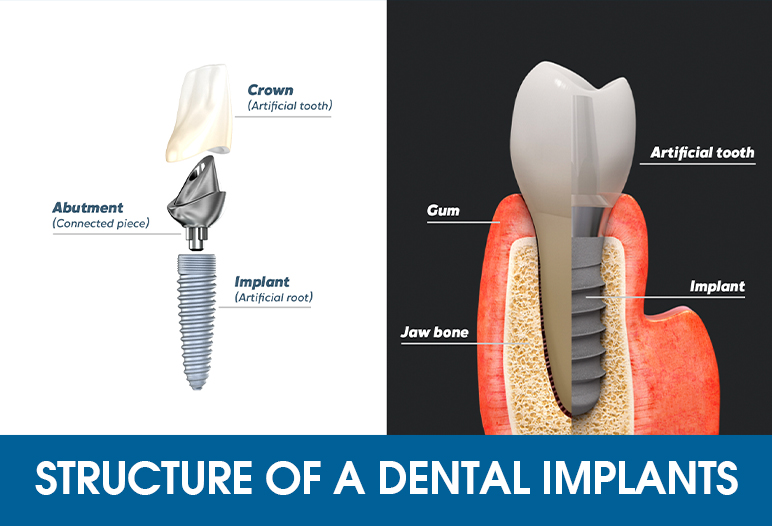If you’ve lost a tooth due to an accident, trauma, or dental issues, there’s no need to resign yourself to a smile with missing teeth. The solution lies in dental implants, a transformative surgical procedure that restores not just your smile but also your confidence. This guide will break down the dental implants step by step, providing clarity on what to expect throughout the process while highlighting the benefits of this innovative dental solution.
Understanding dental implants: An overview of the procedure
Before delving into the detailed steps and components involved in dental implants, it’s crucial to understand what they are and how they function. A dental implant is essentially a metal post or stud that serves as a substitute for the root of a missing tooth. It’s surgically inserted into the jawbone, creating a solid foundation for attaching artificial teeth, crowns, or dentures.
Dental implants are renowned for their durability and natural appearance, making them a preferred choice over traditional dentures or bridges. One of the most significant advantages of opting for dental implants is their ability to prevent bone loss in the jaw, which often occurs when a tooth is missing. This jawbone degradation can result in changes to facial structure over time, leading to an aged appearance.
The procedure involves several stages, starting from the initial consultation to the final placement of the crown. Each step is integral to the success of the overall treatment plan. Let’s explore the steps involved in the dental implant process in detail.
Preparing for dental Implants
Preparation for dental implants is a critical phase that requires careful planning and thorough examination. This stage ensures that the patient is a suitable candidate for the procedure and sets the foundation for successful surgery.

Comprehensive evaluation of oral health
The first step in preparing for dental implants is a comprehensive evaluation of your oral health. Dentists will conduct a thorough examination, including X-rays and 3D imaging, to assess the condition of your gums, jawbone, and remaining teeth.
This evaluation helps identify any underlying dental issues such as gum disease or infections that must be addressed before proceeding with the implant. The dentist may recommend treatments like scaling and root planing to eliminate plaque buildup and restore gum health.
Additionally, assessing the density and volume of the jawbone is crucial. If the bone has deteriorated, bone grafting may be required to create a stable base for the implant. This augmentation process can involve taking bone from another area of your body or using synthetic materials.
Discussing medical history and medications
An open discussion about your medical history is essential in determining whether dental implants are right for you. Patients with certain medical conditions, such as diabetes or heart disease, may require additional precautions or treatment modifications.
Moreover, medications that affect blood clotting or bone healing should be disclosed to your dentist. This conversation will ensure that you receive tailored care that aligns with your specific health needs.
Designing a tailored treatment plan
Once your evaluation is complete and any necessary preparations have been made, your dentist will develop a personalized treatment plan. This plan outlines each step of the dental implant process, the estimated timeline, and any additional procedures needed, such as bone grafting or sinus lifting.
The treatment plan is designed to address your unique dental situation, preferences, and goals. Having clear expectations and understanding the timeline will alleviate any anxiety you may experience as you prepare for surgery.
The surgical stage: Inserting the implant
The surgical insertion of the dental implant represents one of the most vital parts of the entire process. This stage can seem daunting, but understanding what happens during the surgery can help ease any concerns you may have.
Administering anesthesia and ensuring comfort
The first step in the surgical process is administering anesthesia. Depending on the complexity of the procedure and your comfort level, sedation options vary from local anesthesia to general anesthesia.
Local anesthesia numbs the area around the implant site, allowing you to remain awake during the procedure without feeling any pain. General anesthesia, on the other hand, puts you completely asleep, which may be preferred for more complicated cases or anxious patients.
Regardless of the method chosen, the goal is to ensure that you experience minimal discomfort throughout the surgery.

Creating the surgical site
After ensuring your comfort, the dentist will begin the surgical process by making an incision in the gum tissue at the implant site. This incision allows access to the underlying jawbone where the implant will be placed.
Once the incision is made, the dentist drills into the bone at the precise location designated in your treatment plan. Care is taken to create space that matches the dimensions of the implant, ensuring a secure fit.
By carefully removing layers of bone, the dentist minimizes trauma to surrounding tissues, promoting a smoother recovery process.
Inserting the implant and closing the site
With the site properly prepared, the dentist inserts the titanium implant into the drilled hole. Titanium is chosen for its biocompatibility, meaning it integrates well with human bone.
After the implant is securely placed, the gum tissue is stitched back together over the site. In some cases, the implant may be left exposed for immediate loading with a temporary crown; however, oftentimes, it will be buried beneath the gum tissue to allow for proper healing.
Post-surgery, you’ll receive instructions for caring for the surgical site, managing any discomfort, and maintaining oral hygiene during the healing period.
The healing phase: Integration and follow-up
Following surgery, the healing phase is crucial for the long-term success of your dental implants. This phase allows the implant to integrate with the jawbone, forming a strong anchor for future restorations.
Osseointegration: The key to success
Osseointegration refers to the process through which the titanium implant fuses with the surrounding jawbone. During this healing period, which typically lasts from a few weeks to several months, the bone grows around the implant, stabilizing it firmly in place.
It is essential to follow your dentist’s post-operative care instructions during this period. Proper oral hygiene, avoiding hard foods, and attending follow-up appointments will contribute to a smooth integration process.
Occasional check-ups may be scheduled to monitor healing progress and address any potential complications early on.
Dealing with discomfort and managing recovery
While discomfort after the procedure is normal, it’s important to distinguish between typical soreness and signs of complications. Over-the-counter pain relievers or prescribed medication can manage discomfort effectively in most cases. Swelling and inflammation are common, so applying ice packs can also help reduce these symptoms.
During recovery, avoid strenuous physical activities that could disrupt the implant site. Maintaining a soft-food diet can minimize strain on the healing area until the implant has fully integrated.

Follow-Up appointments and adjustments
Regular follow-up visits with your dentist are essential to ensure that the implant is healing correctly and integrating as expected. These appointments allow your dentist to assess osseointegration and make any necessary adjustments to your treatment plan.
Once healing is complete, your dentist will prepare for the next step of the process—placing the abutment and crown.
Completing the process: Abutment and crown placement
After successful healing and osseointegration, the final phase of the dental implant procedure involves placing the abutment and crown. This step transforms your dental implant into a functional and aesthetic replacement for your missing tooth.
Understanding the role of the abutment
The abutment is a small connector piece that sits atop the dental implant. Its purpose is to secure the crown, allowing it to function properly and look natural. The abutment can be constructed from various materials, including porcelain, stainless steel, or titanium.
Placing the abutment typically involves a minor surgical procedure. The dentist will reopen the gum tissue to expose the implant, then screw the abutment onto the implant, securing it in place.
Once the abutment is in position, the gum tissue is stitched around it, and healing time is again necessary to allow your gums to adjust before placing the crown.
Custom fabrication of the crown
With the abutment in place, the next step is creating a custom crown that matches the shape, size, and color of your natural teeth. Your dentist will take impressions of your mouth to ensure that the crown fits seamlessly within your dental arch.
Advancements in dental technology enable the use of high-quality materials that mimic the appearance of natural teeth. Many patients opt for porcelain crowns owing to their aesthetic appeal and resistance to staining.
Final placement and adjustment of the crown
Once your custom crown is fabricated, it’s time for the final placement. The dentist will carefully attach the crown to the abutment, ensuring that it fits comfortably and maintains proper alignment with your existing teeth.
After placement, adjustments may be necessary to refine the bite and ensure optimal functionality. Your dentist will review your new crown, checking for comfort and aesthetic satisfaction.
With the completion of this step, your dental implant procedure is officially finished, and you can enjoy the benefits of a restored smile!
Conclusion
The journey of restoring your smile with dental implants is one filled with anticipation and hope. From preparation to the final placement of the crown, each step is designed to ensure your lasting satisfaction with the results.
Understanding the dental implants step by step empowers patients to approach the procedure with confidence, knowing that they are choosing a reliable and effective solution for missing teeth. Ultimately, the rewards extend far beyond aesthetics—they include improved oral health, enhanced self-esteem, and a brighter future for your smile. By committing to this process, you’re investing in both your dental health and overall quality of life.
Frequently Asked Questions about Personalized Dental Implants
Whether personalized dental implant placement is painful is a typical concern for many patients. To perform this technique, patients are usually given anesthesia, so they will not feel pain or experience any discomfort. After the implant placement, any pain can be managed with pain relief measures as directed by the doctor.
The time for personalized dental implant placement will vary from person to person, depending on the complexity of each case. However, because the implants are custom-made for each patient, it takes more time for the design and manufacturing stages.
To perform this, the doctor will first use advanced technologies such as CT Cone Beam, Oral Scanner, 3D facial scanning, etc., to collect patient data. Then, it will be sent abroad for implant design and manufacturing before being sent back to Vietnam for surgery.
The total process takes about 30-40 days. During that time, the doctor and technicians also need to communicate with each other to reach the final result.
The answer is yes. Personalized implants will be customized to match the patient’s natural teeth, ensuring a lifelike appearance.
Previously, when it first appeared, the success rate of personalized implants was very low, only 30-40%. However, with the support of digital technology, the process of manufacturing implants for individual patients is not only much simpler than before, but the materials are also processed very well, bringing the success rate up to 97-98%.

 Google Reviews
Google Reviews Call
Call
SAIGON IMPLANT CENTER
Best dentist in Vietnam
Saigon Implant Center - Dental Clinic utilizes the latest technology for specialized treatment in the field of Single implant, full jaw implants, All on 4 implants, All on 6 implants, Zygoma implant....
SAIGON IMPLANT CENTER
Best dentist in Vietnam
Saigon Implant Center - Dental Clinic utilizes the latest technology for specialized treatment in the field of Single implant, full jaw implants, All on 4 implants, All on 6 implants, Zygoma implant....